You are using an out of date browser. It may not display this or other websites correctly.
You should upgrade or use an alternative browser.
You should upgrade or use an alternative browser.
SMABAT ST-10S
- Added by baskingshark
- Create date
Admor
New Head-Fier
Pros: +reference tonal balance = not too dark, not too bright
+imaging
+bass
+dynamics
+detailed mids
+highs extension
+they make wow effect
+imaging
+bass
+dynamics
+detailed mids
+highs extension
+they make wow effect
Cons: - stock cable is a complete mistake to pair them with
- they are big, so finding a proper seal is difficult
- they are big, so finding a proper seal is difficult
Intoduction
This is my first review, just decided to post it in the name of justice after reading review of our friend (biocomplex). No hard feelings, mate, but people should know the truth about these little gold guys.
Burn-in
I made a long burn-in, left them to play for a few days at a high volume.
Comfort and fit
I have these for almost two years now. My initial impressions were similiarly bad, but then I started experimenting, as I always do. Curse of the mad scientist I had a hunch that something is wrong. When used with full foams, the sound was horrible. Muffled, devoid of soundstage, but with nice bass. When used with silicone rings, they were painful to use, the sound was good, but lacked lows. So conclusion was clear: make foam rings! In the end I settled with double layer of foam with cut-out inner part. Otherwise, I could not make a proper seal for bass to hit my eardrums. With double layer of foam they are comfortable for me to use and make no pain. Also, the seal is good and lets the bass to show its enormous power.
I had a hunch that something is wrong. When used with full foams, the sound was horrible. Muffled, devoid of soundstage, but with nice bass. When used with silicone rings, they were painful to use, the sound was good, but lacked lows. So conclusion was clear: make foam rings! In the end I settled with double layer of foam with cut-out inner part. Otherwise, I could not make a proper seal for bass to hit my eardrums. With double layer of foam they are comfortable for me to use and make no pain. Also, the seal is good and lets the bass to show its enormous power.
Cable matching
Ohh, and the factory cable! It is horribly wrong for them to be used with. It is some gold-ish, sitty copper, makes them too sterile. They should be used with pure, good quality copper only.
So in the end, I am in love with them.. and I started with harted and anger, that means something.
Amp matching
Matching is important, with BTR5 they were a little too cold, because BTR5 in general is mehh, e10 is also overhyped and I am saying that after testing everything there is on the market. Long live Oriolus, but why so expensive... In the end I tested them with modified Xduoo TA-20 balanced tube amp and now use them with Shanling UP4 which I got for 60$. With Shanling they sound better than with with BTR5, although UP4 is a little messed up, according to ASR. Sonically, for 60$, after comparison with BTR5 which I owned and bought for 100$, I chose Shanling because of its sound signature fitting more in my taste. Design and volume knob made difference for me too.
Sound Quality
The ultimate sound out of them? Great. Really. Bass is perfect, can make your brain vibrate. The best bass from earbuds in my collection, have not heard anything better. It is fast, precise, detailed. Imaging is a complete high end. Saying that after testing throughly GoldPlanar GL2000 and owning Monoprice M1570 for a long time. Soundstage is not big, it feels like a bulb around your head, IEM-type soundstage, exactly as some guys stated before me, BUT it is totally three dimensional bulb with many, many layers and directions for sounds to approach you from! Imaging is on par with high-end IEMs. The mids and highs are very extended, detail retrival is high-end, you just hear everything perfectly. The sound is vivid, not the dark and sweet type, but vivid in a good way, feels real and is quite specacular to dwell in.
Comparison
I have 6 different earbuds, all in range to 30$ through, all are fine, but these? They are just the best of my little collection. The most expensive and the best in this case. Bigger soundstage, better imaging, better bass, better highs extension, better dynamics, just everything. I do not own anything fancy, through. Out of all audio gear, earphones are the least of my interest. I am more into high-end loundspeakers and over-ear headphones.
Audio Experience Level
I guess that my experience in audiofield is something like 9/10. I have produced 12 headphones, modified few loudspeakers and amplifiers. I had bought, sold and tested way over 100 audio devices: 30-40 pairs of loudspeakers, 20-30 stereo amps, 20-30 pairs of over/around ear headphones, 5-10 DACs, 10-15 headphone DAC/amp, 9 IEMs, 6 earphones.
So, if you ever have the chance to grab them cheap, do so. Remember about cutting the foams and using different cable! Of course careful amp matching is needed too. You will not be disappointed.
Thanks for your attention. Best Wishes from Poland.

This is my first review, just decided to post it in the name of justice after reading review of our friend (biocomplex). No hard feelings, mate, but people should know the truth about these little gold guys.
Burn-in
I made a long burn-in, left them to play for a few days at a high volume.
Comfort and fit
I have these for almost two years now. My initial impressions were similiarly bad, but then I started experimenting, as I always do. Curse of the mad scientist
 I had a hunch that something is wrong. When used with full foams, the sound was horrible. Muffled, devoid of soundstage, but with nice bass. When used with silicone rings, they were painful to use, the sound was good, but lacked lows. So conclusion was clear: make foam rings! In the end I settled with double layer of foam with cut-out inner part. Otherwise, I could not make a proper seal for bass to hit my eardrums. With double layer of foam they are comfortable for me to use and make no pain. Also, the seal is good and lets the bass to show its enormous power.
I had a hunch that something is wrong. When used with full foams, the sound was horrible. Muffled, devoid of soundstage, but with nice bass. When used with silicone rings, they were painful to use, the sound was good, but lacked lows. So conclusion was clear: make foam rings! In the end I settled with double layer of foam with cut-out inner part. Otherwise, I could not make a proper seal for bass to hit my eardrums. With double layer of foam they are comfortable for me to use and make no pain. Also, the seal is good and lets the bass to show its enormous power.Cable matching
Ohh, and the factory cable! It is horribly wrong for them to be used with. It is some gold-ish, sitty copper, makes them too sterile. They should be used with pure, good quality copper only.
So in the end, I am in love with them.. and I started with harted and anger, that means something.
Amp matching
Matching is important, with BTR5 they were a little too cold, because BTR5 in general is mehh, e10 is also overhyped and I am saying that after testing everything there is on the market. Long live Oriolus, but why so expensive... In the end I tested them with modified Xduoo TA-20 balanced tube amp and now use them with Shanling UP4 which I got for 60$. With Shanling they sound better than with with BTR5, although UP4 is a little messed up, according to ASR. Sonically, for 60$, after comparison with BTR5 which I owned and bought for 100$, I chose Shanling because of its sound signature fitting more in my taste. Design and volume knob made difference for me too.
Sound Quality
The ultimate sound out of them? Great. Really. Bass is perfect, can make your brain vibrate. The best bass from earbuds in my collection, have not heard anything better. It is fast, precise, detailed. Imaging is a complete high end. Saying that after testing throughly GoldPlanar GL2000 and owning Monoprice M1570 for a long time. Soundstage is not big, it feels like a bulb around your head, IEM-type soundstage, exactly as some guys stated before me, BUT it is totally three dimensional bulb with many, many layers and directions for sounds to approach you from! Imaging is on par with high-end IEMs. The mids and highs are very extended, detail retrival is high-end, you just hear everything perfectly. The sound is vivid, not the dark and sweet type, but vivid in a good way, feels real and is quite specacular to dwell in.
Comparison
I have 6 different earbuds, all in range to 30$ through, all are fine, but these? They are just the best of my little collection. The most expensive and the best in this case. Bigger soundstage, better imaging, better bass, better highs extension, better dynamics, just everything. I do not own anything fancy, through. Out of all audio gear, earphones are the least of my interest. I am more into high-end loundspeakers and over-ear headphones.
Audio Experience Level
I guess that my experience in audiofield is something like 9/10. I have produced 12 headphones, modified few loudspeakers and amplifiers. I had bought, sold and tested way over 100 audio devices: 30-40 pairs of loudspeakers, 20-30 stereo amps, 20-30 pairs of over/around ear headphones, 5-10 DACs, 10-15 headphone DAC/amp, 9 IEMs, 6 earphones.
So, if you ever have the chance to grab them cheap, do so. Remember about cutting the foams and using different cable! Of course careful amp matching is needed too. You will not be disappointed.
Thanks for your attention. Best Wishes from Poland.

Last edited:
biocomplex
New Head-Fier
Pros: -comparable to previous version is much lighter (aluminum shell?)
-quite nice bass, not that it became better than first model
-convenient fit
-quite nice bass, not that it became better than first model
-convenient fit
Cons: -shallow medium and high frequencies
-bad assembly quality
-cheap dynamic driver
-hugely overpriced
-bad assembly quality
-cheap dynamic driver
-hugely overpriced
Everything being said is concerning gold 150 Ohm version of st10s. I happened to obtain cheaply gold version of Smabat st10s. at first glance i was confused because gold color was almost transparent, and thought that seller messed up and sent me silver version, but after checking resistance with multi-meter it showed honest 150 Ohm.
First impression that they are almost weightless, in my memory first version felt was quite hefty in ear, but in my opinion less weight - better. Another thing - earbuds had unpleasant sound of wobbling inside, maybe long loose wire?
Secondly, they just have no scene, trying to find at least something interesting in high and mids but they were just too descended. it felt like earbud are a bit deaf. Even low frequency not saving the day. I remember how deep were lows in previous version of st10, here they are just good, nothing more.
Being quite disappointed by sound i decided to see what kind of driver smabat decided to insert in those earbud, and well.. it is saddening. Inside is cheap dual material membrane driver (plastics/metal), wires are already frayed near the driver (nice quality from manufacture) and in my opinion for this build quality and driver choice eabuds are just overpriced, totally a letdown. But it might be a good shell for some decent driver if you had them dirt cheap and like diy ¯\_(ツ)_/¯
First impression that they are almost weightless, in my memory first version felt was quite hefty in ear, but in my opinion less weight - better. Another thing - earbuds had unpleasant sound of wobbling inside, maybe long loose wire?
Secondly, they just have no scene, trying to find at least something interesting in high and mids but they were just too descended. it felt like earbud are a bit deaf. Even low frequency not saving the day. I remember how deep were lows in previous version of st10, here they are just good, nothing more.
Being quite disappointed by sound i decided to see what kind of driver smabat decided to insert in those earbud, and well.. it is saddening. Inside is cheap dual material membrane driver (plastics/metal), wires are already frayed near the driver (nice quality from manufacture) and in my opinion for this build quality and driver choice eabuds are just overpriced, totally a letdown. But it might be a good shell for some decent driver if you had them dirt cheap and like diy ¯\_(ツ)_/¯
.Attachments
View previous replies…
A
Admor
and one question, please. are you earphones driver producer? do you have experience and knowledge regarding production cost of the earbud drivers? because you called these "cheap". I do not posses such knowledge, so I cannot say if that is true. do you, my friend? I would be pleased to meet somebody with actual knowledge of this magic 

B
biocomplex
Since you had enough cheek to demand deleting my review I can only suppose that you will afterwards immediately delete your account from this forum.
Magic of "burn in" can be found in magic continent of unicorns, as far as I'm informed we live in galaxy where it still wasn't discovered.
My subjective review is based on my experience in diy field and listening to many other earbuds.
The fact that you have used them for two ears doesn't means anything except that you haven't listened to anything better in that period of time and thus trying impose your subjective opinion.
Magic of "burn in" can be found in magic continent of unicorns, as far as I'm informed we live in galaxy where it still wasn't discovered.
My subjective review is based on my experience in diy field and listening to many other earbuds.
The fact that you have used them for two ears doesn't means anything except that you haven't listened to anything better in that period of time and thus trying impose your subjective opinion.
B
biocomplex
Hearing all the disturbance about those earphones i decided to look at them one more time and to experiment a little.
First of all my opinion about nice bass and thin mids are the same, highs after all i believe are more shouty after all.
Second attempt was with removed faceplate since by sound signature it looked like drivers don't have enough air to normally articulate. And it definitely was worth doing it since all unpleasant sharpness just disappeared. It started to sound like more or less balanced earbud, well if considering a bit raised bass and laid back mids and highs. But still resolution is quite simple in upper range, so signature became more warm. So after all it is not about unit driver being bad but ability of Smabat to tune correctly driver in their shells. ALL of this is my personal SUBJECTIVE opinion of Smabat st10s 150 Ohm version.
First of all my opinion about nice bass and thin mids are the same, highs after all i believe are more shouty after all.
Second attempt was with removed faceplate since by sound signature it looked like drivers don't have enough air to normally articulate. And it definitely was worth doing it since all unpleasant sharpness just disappeared. It started to sound like more or less balanced earbud, well if considering a bit raised bass and laid back mids and highs. But still resolution is quite simple in upper range, so signature became more warm. So after all it is not about unit driver being bad but ability of Smabat to tune correctly driver in their shells. ALL of this is my personal SUBJECTIVE opinion of Smabat st10s 150 Ohm version.
Wiljen
Headphoneus Supremus
Pros: Lots of detail, good low end, very clean signature, polite treble
Cons: lacks a little weight and warmth to the mids.
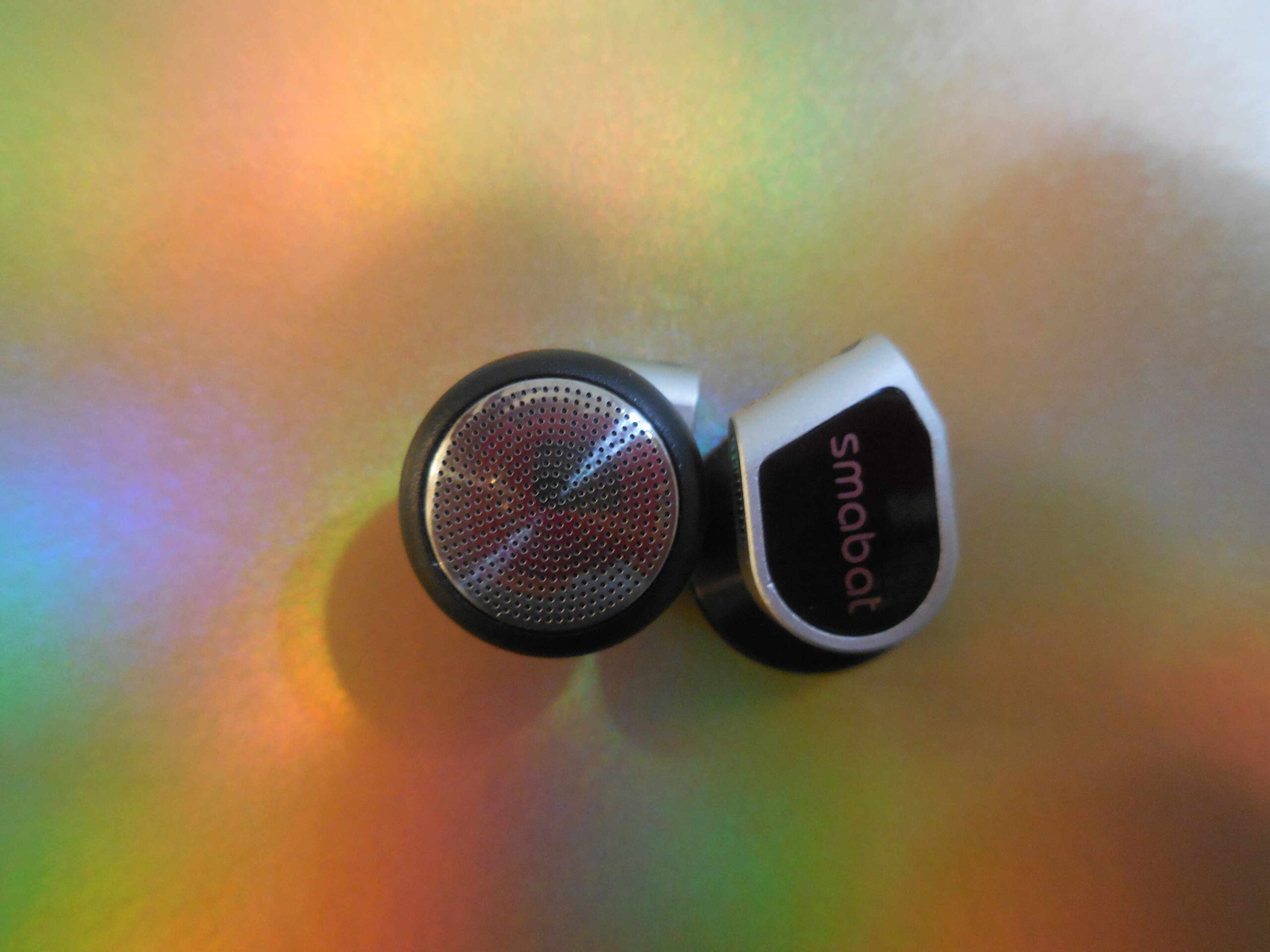
Disclaimer: NiceHCk sent the ST10s for review because I had reviewed the ST10 and M2 Smabat models previously. I was interested to hear the new Smabat offerings and how they would compare to the original. I hope to add the gold model as well soon. If you have an interest in purchasing the Smabat ST10s, check with NiceHCk via their aliexpress store.
Unboxing / Packaging:
The ST10s ships in a flat black slip-cover box with the Smabat name on the front in Gloss black. This is a bit more subdued than the original with its gold labeling. The rear has a label with model number and basic specs. Once the slip is removed, lifting the cover reveals the buds displayed in a card, stock covered foam. The reverse side has the foams tucked neatly in holes cut in the foam while the cable rests in a small box in a notched cutout in the foam. beneath that, a lower layer has the warranty card, manual, and carry bag. Kit is fairly standard with foams, and rubber earpeice covers, cable, and case. Foams include both solid and donut models so pretty much all the earpiece options are covered. I generally choose to listen without any cover on the tips as it has a tendency to impact the sound. I do like the rubber covers though for exercise use as they make the buds much easier to seat and retain during periods of movement.




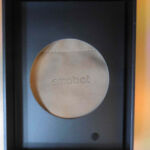

Build/Fit:
Like previous models, the St10s uses a 15.4mm driver so the earpieces are necessarily large to house the driver, but taper quickly behind that so fit is still fairly easy for most. Those with small ears may wish to audition these before purchase to avoid any issues size may cause. About ½ way up the taper is a small silver band with small vents immediately to the outer portion of the cone. These are spaced to avoid blocking them with the earpieces worn tip up and some adjustment may be needed to prevent blocking them if worn tip down as I found. Most of what changes by blocking the vents is the lower mid-range so if you suddenly have clouded mids, check your vents.
The outer housing shares the transmission line style venting of the original ST10 but is supposedly an improved version for even more bass depth. The housings have a silver outlined black face gray/green outer shell with the driver housing being primarily black plastic. Fit and polish are good with no gaps around the mmcx connector and all edges slightly beveled for comfortable wear. Left and right are labeled on the spine of the housing leading to the mmcx connectors. MMCX connectors are good and tight (unlike my assessment of the original).


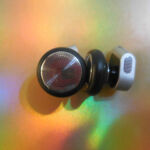

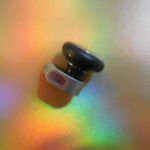


Internals:
The Driver used in the st10s is a 15.4 mm dynamic driver with a titanium coated peek diaphragm. Nominal impedance is listed at 40Ω with a sensitivity of 115dB/mW. The original had slightly higher impedance and slightly lower sensitivity and really required a solid amp to do its best work. I am happy to report that this new ST10S silver is usable from a cell phone or tablet and while using a higher powered source will give it a bit more low end punch at times, it doesn’t feel anywhere near as under-powered as the original did when run from the same phone. The Transmission line cabinet has long since been a staple of speaker design but hasn’t been used much for headphones or earphones as it takes up a good bit of space compared to a standard vented design. Smabat is now on its 3rd generation of this housing and keeps tweaking it with each new revision. It is interesting as a pure engineering experiment to look at the generations of product in this respect.



Cable:
The cable provided with the original ST10 was also a bit outside the norm as it isn’t often we see an earbud with a cable designed for tip-up only wear. It seems maybe enough people found that odd to result in the changes we see in the ST10S version. Gone is the cloth coating with the cable now being housed in a clear casing showing off the silver plated copper cable. At the lower end, the cable uses a 3.5mm straight jack with a polished metal housing and a short strain relief. The splitter matches the jack in style and has a clear plastic chin slider above it which is well fitted and stays put when set. The top end still use mmcx connectors, this time in clear/metal housings without earhooks. The metal is marked clearly with L/R for indexing purposes. Interestingly I mentioned preferring the ALO tinsel cable to the original provided with the ST10 and the ST10s now ships with a cable that is very similar in style and construction to the Tinsel, so either they took my advice or it was pure coincidence. Either way, I like this new cable considerably better than the 1st generation.


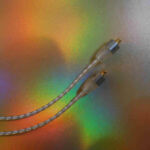
Tips:
The ST10s provides, foams, donut foams, and a vented rubber tips. I found that the rubber tips did help with keeping the ST10s from migrating during activity but found it to be the most signature changing of the three and decided for sake of this review I would conduct all sound notes with none of the tips installed. Understand that your impressions will vary if you install tips and especially the rubber tips.

Sound:

Remember that looking at the FR chart on an earbud is always misleading as buds are not meant to be sealed and almost every test rig is going to seal the face of the driver to a greater degree than actual wear.
Bass:
I was surprised by the amount of sub-bass on the original ST-10 so this time it came as less of a surprise. Sub-bass is still very good with more presence than most earbuds. It won’t satisfy bassheads, but gives the 10s a near neutral tuning without feeling like the low end is rolled off or forgotten. Mid-bass is roughly level with the sub-bass and has good clarity and detail. A lot of the clarity is due to the speed of the driver which is faster than most on both attack and decay but stops short of being too quick and impacting note weight. Mid bass bleed is very minimal as a result of the tuning and driver speed. I had noted a bit of artificial sound to the original ST-10 and am happy to report the 10s is a bit more natural in tone.
Mids:
As mentioned, mid-bass bleed doesn’t obstruct the lower mids which have the same clarity and detail as the lows but lean slightly to the cooler/thinner side. It is clear in the mids that Smabat prioritized clarity over warmth. Having said that, guitar growl is still believable if not quite as aggressive as could be. I found male vocals to be just slightly behind female and a touch less lively but still well defined. Female vocals cut through the mix and do border on stridency at times but do a good job of walking the line and not getting sibilant. Strings lack a bit of weight but again have good clarity.
Treble:
Lower treble has good energy and follows the upper mids before falling back a bit as we move up. The treble is polite and well detailed with some air but sparkle feels a bit limited. Extension is good with final roll-off being above my hearing, but it does drop back in volume above about 8kHz which may be the reason sparkle feels a little reserved. Speed shows in the treble as well with snare having a crisp-edged attack and cymbals having good sharpness as well without becoming clicky.
Soundstage / Imaging:
Soundstage is roughly the same size as the ST-10 with good depth and width and even some sense of height. The driver speed contributes above average instrument separation which makes seating the orchestra straight forward with no large gaps or misplacements. Imaging is good but due to the open nature of the buds the positions are sometimes a bit more general than exacting. Layering is quite good for a single driver with little tendency to thicken on complex tracks.
Comparisons:
Smabat ST-10
Shells are a wash as is the cable so sound is the distinguishing factor between the original and the S. The S is as bit more neutral and a bit faster while the original is a bit more weighty and a touch warmer if a bit less detailed. I found the bass slightly less emphasized and detail retrieval a bit better. If you like the ST-10 but wanted a bit more clarity, the 10s will be well received.
NiceHCK EBX
Build Quality – Buds themselves are roughly equal with the EBX kit being a bit higher quality than that of the 10s.
Sound – EBX is thicker and less detailed in the mid-bass and lower mids, giving it a warmer richer tone at the expense of detail. The 10s offers a bit more sub-bass and cleaner mid-bass and mids but lacks a touch of warmth in comparison. Vocals are a bit more lifelike on the 10s as a result of the tuning. The EBX needs less power to drive well so may be a choice for those limited to lower powered sources. I prefer the clarity of the 10s and the more natural voicing.
LYRA Classic
Build Quality – The Lyra would win hands down if not for the fixed cable. The buds are roughly equal but the kit is much improved on the Lyra.
Sound – I picked the Lyra over the original ST-10 for its more natural tonality and while the 10s makes moves in the right direction, it doesn’t quite get to the level of the Lyra. The 10s is better extended and has considerably more sub-bass so will appeal to those who want a similar tonality to the Lyra without sacrificing lows to get it. While the Lyra bettered the detail retrieval of the original ST-10, the 10s is now roughly on par with it. The Lyra remains easier to drive, but the 10s also closes the gap some here too.
Thoughts / Conclusion:
The original St-10 proved the transmission line style case was more than just a gimmick and could actually produce a good sounding earbud. The 10s proves that SMABAT continues to refine that design and improves on an already good listen. I found the 10s (silver) a bit cleaner and faster than the original with a slightly leaner tone and a bit less boosted female vocals while still retaining some emphasis to keep them ahead of the other instrumentation. The 10S retains the bass depth of the original and the top end extension, but cleans up the territory between the two. The one knock will likely be that they are slightly on the thin/cool side and some will miss the warmth of the original. The ST-10s certainly deserves an audition if you are looking for earbuds as the clarity is probably as good as it gets for the price. Its just a matter of whether the tuning works for you.
cqtek
1000+ Head-Fier
Pros: Sound sensation similar to that offered by some IEMS.
- Scene.
- Neutral and clear sound.
- Depth of the lower zone.
- Design.
- Ergonomics.
- Scene.
- Neutral and clear sound.
- Depth of the lower zone.
- Design.
- Ergonomics.
Cons: Accessories: Few foams and non-rigid bag.
- Rigid cable.
- Unnatural sub-bass.
- Upper zone partially incomplete.
- Rigid cable.
- Unnatural sub-bass.
- Upper zone partially incomplete.
Introduction
Smabat continues to grow and based on the acclaimed ST-10, has created two new earbuds: ST-10s Silver and ST-10s Gold. One difference between them is their impedance: 40Ω for the Silver version, 150Ω for the Gold version. The other is based on the composition of the diaphragm. Compared to the ST-10 version, the particular maze-shaped structure is larger, the driver has been revised and the cable has been changed. For the Silver version, the new driver uses a similar configuration, whose diaphragm is 3 layers, but revised to version 2.0. Meanwhile, the Gold version, uses a particular diaphragm, which aims to generate a different sound, somewhat cooler.
On the sound level, the version to be revised, which is the Silver, is a kind of mix between the old ST-10 and the M1. It maintains the power of the lower zone of the first ST-10, but improves the refinement, adopting, also, the more detailed and vivid profile, of the M1.
Let's see, in depth, the improvements of this new version.


Specifications
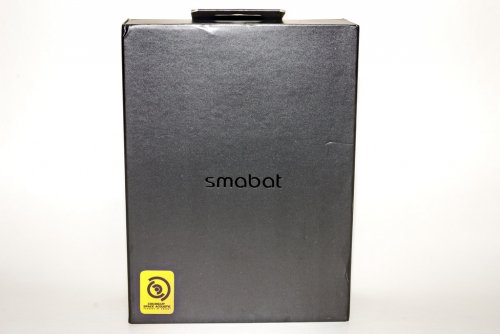

Packaging
This time, the Smabat ST-10s comes in a box with smaller dimensions than its previous version: 131x99x39mm. Its color is satin black. On the front face there are only inscribed, the letters "smabat", plus a yellow sticker, in the lower left corner, with the content of in icon, under the phrase "Coiling-Up Space Acoustic. Powered By Smabat". On the back side, another sticker, this time on the bottom, containing the specifications, the brand logo and its address.
After sliding the box, the capsules are shown, stuffed in a rigid foam mould, lined with black cardboard. After lifting the mould, a large round hole can be seen, behind which a brown leatherette cover with the brand name can be seen. On the back of the mould where the capsules come, the tips are embedded. As a summary, the complete content is:
The packaging is slightly different from the base model, the cover seems more useful, with a flexible band closure, more suitable. Although it is small and not rigid. The tips are still very scarce and insufficient. As an accessory, the silicone tips are repeated, of doubtful utility.
I think that in this aspect, the variations are minimal and the accessories are not up to the price and its claim of a premium product or flagship.
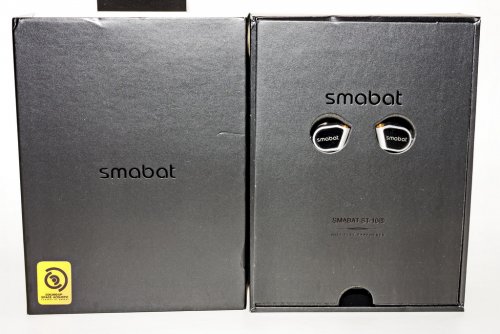

Construction and Design
The external design has hardly changed from its predecessor, except that the maze-like structure is larger. It changes the color, now it's black and silver. The cable, also different, is made of silver-plated strands, covered by transparent plastic. It's similar to the M1 cable. It has no guides over the ear and its connections are MMCX, gold-plated.
Otherwise everything is very similar: The earbuds are formed by two capsules joined by a relatively thick central axis. In the rear capsule is the acoustic cavity. In the front capsule is the driver. Smabat uses a titanium diaphragm, three layers (PEEK, PU and PEEK), a patented acoustic cavity, made of aluminium, in the shape of a labyrinth. In addition, they use an advanced acoustic and ergonomic design. 9448A plates are used to seal the labyrinth. The outer plates are made of steel. The MMCX connections are gold plated. Under the labyrinth piece, there is a large bass port, covered with a grill. There are holes in the cones of the capsules.
As I say, the design hardly changes, although the colours are more flattering and elegant.
The cable has a slight rigidity, which I don't like, but the absence of guides, allows the use downwards or over the ear. Although, the sound is not the same, I prefer the classic use, over the ear.

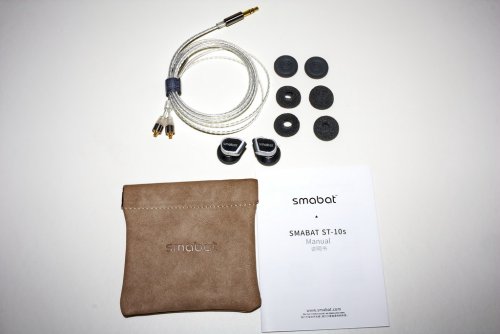
Adjustment and Ergonomics
The peculiar design, allows its use on ear and the absence of guides in the cable, offers the possibility of being placed with the cable down. However, it is true that the rigidity of the cable and the absence of guides makes the over-the-ear fit less durable. The ergonomics have not changed, but the cable is still inadequate for the design of the earbuds. Fortunately, it can be changed.
As a result, the best fit for the fullest, most complete sound is a bit complex and not very suitable for use on the move, as the slightest mismatch can ruin the production of the best sound.

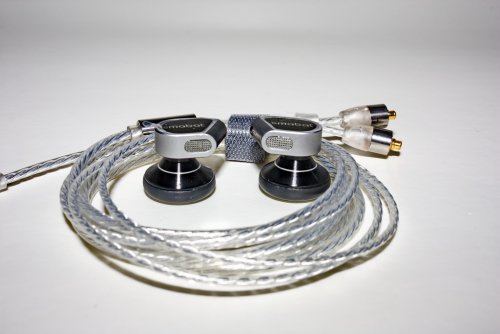
Sound
Profile
As I've been saying, the Smabat ST-10S sails between its predecessor and the M1. In this way, their profile is a compendium between both models, since they balance, on one hand, the low part of the ST-10 and the mids of the M1, getting a more neutral and balanced sound, offering a good punch in the low zone, less forced and natural mids and soft, but aired highs.
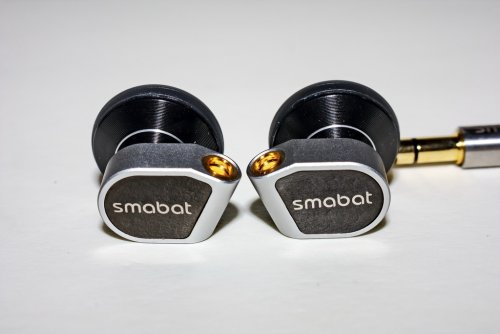
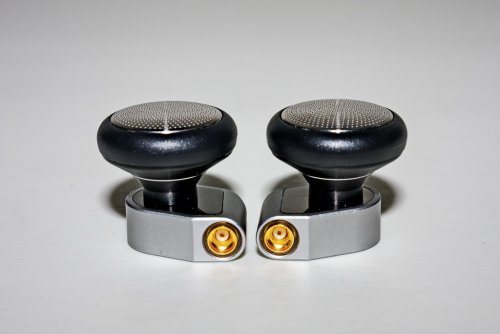
Bass
The improved enclosure of the S version is noticeable in several ways: the depth and width of the bass have been increased. The impact is more moderate than in the previous version, but the clarity and precision are also greater. The result is a bigger scene and a more spacious sound, which is noticeable from the first beats.
The texture of the lower zone is perceived as softer, sweeter, more pleasant, with a compact and rounded hit, of remarkable power and execution at the same time. The speed neutralizes its power and gives it notoriety, both at the level of resolution, as in the details and different planes. The set generates an area never swollen, which turns towards the naturalness and that full sensation, halfway between the sound produced with IEMS (for its execution and level) and some acoustic boxes (for its power of recreation, openness and realistic depth).
The sub-bass range is perceived, but it is in this area where the colour and texture is lost, and the naturalness of the rest of the lower area is affected, and its performance is somewhat more limited in quality.

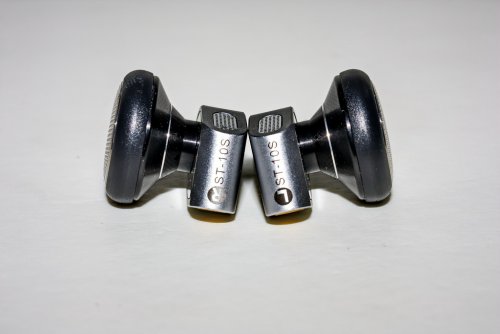
Mids
The clear vocation of model S is aimed at greater neutrality, something that is demonstrated in the central range. It is here that realism and naturalness are raised to their best. The mid-range feels quite liberated from the lower zone and clarity is perceived as increased, as well as space and separation. The comparative warmth is rather less, one could even say that the tonality of the mids is somewhat colder. In this sense, this fact is not harmful, since it helps to reduce, until disappearance, any sensation of mud. The lights of the range outweigh the shadows and the darkness is neutralized, helping to recreate a natural tone, but colder, somewhat narrower, but more vivid and of finer, delicate and higher tone. But this should not lead you to think that the ST-10S are sibilant at all, as they have good control in this sense, because the range retains a remarkable linearity.
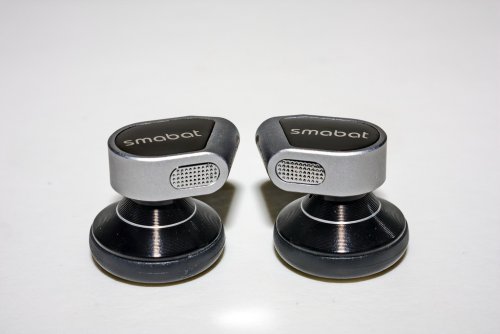

Treble
The upper area is not notable for its brightness, but for the amount of air. The highs are gentle, not too sparkling, but clearly noticeable. Its slightly cool character is due to this tuning of the high band. Without being totally explicit, the details are easily distinguishable, providing a good amount, especially at the macro level. There is no emphasis on this band, compared to the other two, but it is not neglected either. The highs maintain the profile that seeks neutrality, perhaps too much. They are fine and smooth, focusing more on producing a good amount of air, than showing a surreal amount of presence. Although, it is possible that some transients, towards higher levels, are perceived slightly sunken, diminishing some qualities and limiting a more uniform response.


Soundstage, Separation
Another strong point of the ST-10S, is the great feeling of amplitude that they produce. Starting from the depth of the lower area, this new model presents, if possible, a wider, more extensive and longer stage. The three-dimensionality is perceived frontally, without being totally spherical.
The image enjoys very good positioning and the separation favours a wide range of details from all points of the scene. There is a remarkable degree of cleanliness and clarity, although the micro detail is simply good.

Comparisons
Smabat ST-10
Comparison forced between predecessor and successor. I will skip the differences in packaging, cable, accessories and design and focus on the hearing differences. The first impression is clear: these are two different tunings, despite the aesthetic similarities. The ST-10 has a more energetic sound, in all bands, with a more noticeable low zone, a more advanced, warm midrange and more sparkling and vivid highs. In contrast, the S version has a less exposed sound, somewhat more backward, relaxed, not so much in the foreground. This happens in all its ranges, but it is especially noticeable in the midrange, where the voices don't have the weight, body and direct feeling that the previous version offers. If we analyze range by range, the S version, in its lower zone, has a remarkable width, offering well-drawn bass, more content, neutral, less swollen, with better control and more planes. In the previous version, the impact is greater, they are more extensive, with a slower decay, which provides a darker and more charged pose. However, the sub-bass, its power, sonority and naturalness, has not been overcome in the new version.
In the middle zone, again, there are clear differences. In the old version, it is somewhat influenced by the lower zone, because of its warmth and extension. In this way, the lower mid-range is fuller, with more body, presence and closeness. The S version, on the other hand, stands out for its greater neutrality, offering even a colder, thinner, clearer and more open tone. It is true that the proximity is also more relaxed, generating a less direct sound, but something more balanced, not as compact as in the previous version. Voices feel different: while the ST-10 sounds warmer and fuller, the ST-10S feels more liberated and less heavy, with more detail and a finer pattern, with a higher resolution and clarity profile. They are really two different proposals, but both have their great moments. For male voices I prefer the ST-10 and for female voices I prefer the S version.
Finally, the high zone has been redefined a lot in the S version. The previous model is much more explicit and free, generating more sparkling and marked highs. The S version has more control, and even feels a bit restrained, as its notes are more limited and contained.
The scene is presented differently in both earbuds. The more relaxed sound of the new version offers a wider scene feeling. While the old version, with its closer and more powerful sound, offers a more foreground representation, which is also not lacking in scene, but is demonstrated in other parameters, such as height. With all this, the stage feels more intimate in the ST-10, while the S sounds more open and ethereal, offering a more open and semi-spherical stage.
The better clarity and lower density of the S version offers a superior point of separation and instrumental recreation.
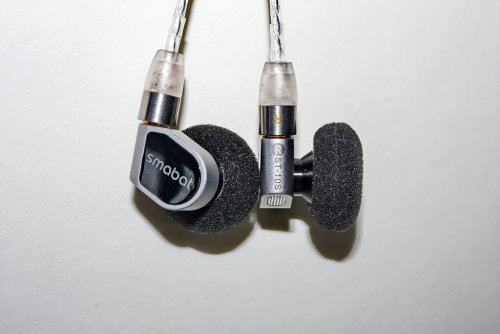
Smabat M1
Without a doubt, one of the kings of value for money are the M1s. Its stubbier shape, a priori more uncomfortable, offers the best fit of the whole family, as its roundness and size, allows me a freer fit.
At a sound level, the comparison between both is more obvious. The ST-10S has an improved, enlarged and powerful low range, except in the sub-bass area. The M1, in the lower end, are more trimmed; but, still, its sonority is a little more realistic. The rest of the range is more innocuous, with simpler development, more limited presence and emphasis, more contained depth and less descriptive capability. With all this, the M1s retain a good colour and a pleasant, smooth texture in their bass.
The midrange presents a different exposure. ST-10S sound clearly more neutral and cooler. In the M1, the voices are more present and close, feeling fuller, due to its more central and warm profile. However, it seems that the details, instrumentation and overall recreation of the middle zone, enjoy greater resolution and amount of detail, in the ST-10S.
I find more coherence and balance in the upper zone of the M1. Its highs are more explicit and, although it has less air, they look more natural, since it lacks irregularities.
The little brother M1, can't compete with the amplitude of the scene of the new ST-10S. Comparatively speaking, the M1s are simpler and more limited in this respect, despite the cleanliness of their sound. The difference is clear, the sensation of width is felt from the first moment, observing a greater depth, quantity of planes, descriptive power and better instrumental recreation, as well as a more precise and defined global positioning. The separation also goes hand in hand, a bigger sound generates more silence and therefore an equal separation.
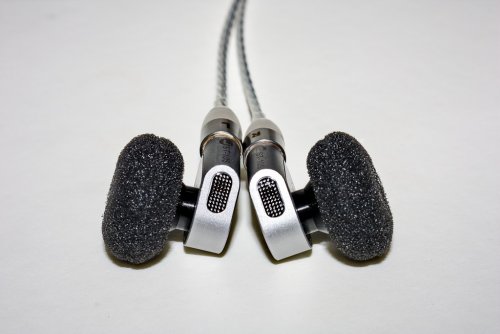
Conclusion
Smabat is opening a coherent path. Its new models are not mere iterations, but seek to offer new sensations. This time, the ST-10S have taken the characteristics of the two previous models, to create a different tuning, which is halfway between both, gaining in scene and separation, but offering a unique sound and not continuous, aimed at neutrality. And there lies its virtue, since there are improvements, but also innovations and differences. And that is something I value, very positively, about this brand. We will continue, totally attentive, to the new movements of Smabat...
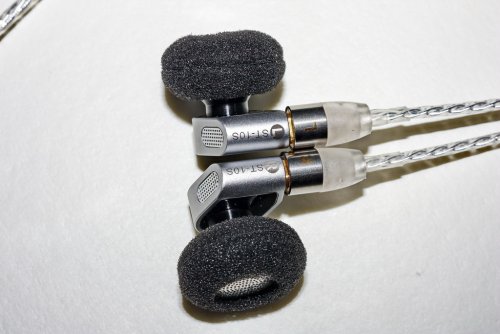
Sources Used During the Analysis
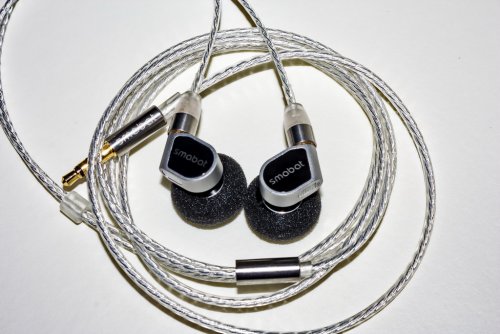
Ratings
Purchase link
https://es.aliexpress.com/item/4000947129148.html
You can read the full review in Spanish here:
https://hiendportable.com/2020/07/09/smabat-st-10s-review/
Smabat continues to grow and based on the acclaimed ST-10, has created two new earbuds: ST-10s Silver and ST-10s Gold. One difference between them is their impedance: 40Ω for the Silver version, 150Ω for the Gold version. The other is based on the composition of the diaphragm. Compared to the ST-10 version, the particular maze-shaped structure is larger, the driver has been revised and the cable has been changed. For the Silver version, the new driver uses a similar configuration, whose diaphragm is 3 layers, but revised to version 2.0. Meanwhile, the Gold version, uses a particular diaphragm, which aims to generate a different sound, somewhat cooler.
On the sound level, the version to be revised, which is the Silver, is a kind of mix between the old ST-10 and the M1. It maintains the power of the lower zone of the first ST-10, but improves the refinement, adopting, also, the more detailed and vivid profile, of the M1.
Let's see, in depth, the improvements of this new version.


Specifications
- Drivers: Dynamic 15.4mm Three-layer Diaphragm 2.0 (PEEK, PU, PEEK Titanium Diaphragm)
- Frequency response: 10-22000Hz
- Sensitivity: 115dB±3/mW
- Impedance: 40Ω
- Distortion Ratio: <0.1% @1kHz
- Jack connector: 3.5mm
- Capsule connection type: MMCX
- Cable size: 1.2m


Packaging
This time, the Smabat ST-10s comes in a box with smaller dimensions than its previous version: 131x99x39mm. Its color is satin black. On the front face there are only inscribed, the letters "smabat", plus a yellow sticker, in the lower left corner, with the content of in icon, under the phrase "Coiling-Up Space Acoustic. Powered By Smabat". On the back side, another sticker, this time on the bottom, containing the specifications, the brand logo and its address.
After sliding the box, the capsules are shown, stuffed in a rigid foam mould, lined with black cardboard. After lifting the mould, a large round hole can be seen, behind which a brown leatherette cover with the brand name can be seen. On the back of the mould where the capsules come, the tips are embedded. As a summary, the complete content is:
- Smabat ST-10S.
- 1 pair of plastic tips.
- 2 pairs of foam tips.
- 1 cable.
- Brown leatherette bag
- Instructions.
The packaging is slightly different from the base model, the cover seems more useful, with a flexible band closure, more suitable. Although it is small and not rigid. The tips are still very scarce and insufficient. As an accessory, the silicone tips are repeated, of doubtful utility.
I think that in this aspect, the variations are minimal and the accessories are not up to the price and its claim of a premium product or flagship.


Construction and Design
The external design has hardly changed from its predecessor, except that the maze-like structure is larger. It changes the color, now it's black and silver. The cable, also different, is made of silver-plated strands, covered by transparent plastic. It's similar to the M1 cable. It has no guides over the ear and its connections are MMCX, gold-plated.
Otherwise everything is very similar: The earbuds are formed by two capsules joined by a relatively thick central axis. In the rear capsule is the acoustic cavity. In the front capsule is the driver. Smabat uses a titanium diaphragm, three layers (PEEK, PU and PEEK), a patented acoustic cavity, made of aluminium, in the shape of a labyrinth. In addition, they use an advanced acoustic and ergonomic design. 9448A plates are used to seal the labyrinth. The outer plates are made of steel. The MMCX connections are gold plated. Under the labyrinth piece, there is a large bass port, covered with a grill. There are holes in the cones of the capsules.
As I say, the design hardly changes, although the colours are more flattering and elegant.
The cable has a slight rigidity, which I don't like, but the absence of guides, allows the use downwards or over the ear. Although, the sound is not the same, I prefer the classic use, over the ear.


Adjustment and Ergonomics
The peculiar design, allows its use on ear and the absence of guides in the cable, offers the possibility of being placed with the cable down. However, it is true that the rigidity of the cable and the absence of guides makes the over-the-ear fit less durable. The ergonomics have not changed, but the cable is still inadequate for the design of the earbuds. Fortunately, it can be changed.
As a result, the best fit for the fullest, most complete sound is a bit complex and not very suitable for use on the move, as the slightest mismatch can ruin the production of the best sound.


Sound
Profile
As I've been saying, the Smabat ST-10S sails between its predecessor and the M1. In this way, their profile is a compendium between both models, since they balance, on one hand, the low part of the ST-10 and the mids of the M1, getting a more neutral and balanced sound, offering a good punch in the low zone, less forced and natural mids and soft, but aired highs.


Bass
The improved enclosure of the S version is noticeable in several ways: the depth and width of the bass have been increased. The impact is more moderate than in the previous version, but the clarity and precision are also greater. The result is a bigger scene and a more spacious sound, which is noticeable from the first beats.
The texture of the lower zone is perceived as softer, sweeter, more pleasant, with a compact and rounded hit, of remarkable power and execution at the same time. The speed neutralizes its power and gives it notoriety, both at the level of resolution, as in the details and different planes. The set generates an area never swollen, which turns towards the naturalness and that full sensation, halfway between the sound produced with IEMS (for its execution and level) and some acoustic boxes (for its power of recreation, openness and realistic depth).
The sub-bass range is perceived, but it is in this area where the colour and texture is lost, and the naturalness of the rest of the lower area is affected, and its performance is somewhat more limited in quality.


Mids
The clear vocation of model S is aimed at greater neutrality, something that is demonstrated in the central range. It is here that realism and naturalness are raised to their best. The mid-range feels quite liberated from the lower zone and clarity is perceived as increased, as well as space and separation. The comparative warmth is rather less, one could even say that the tonality of the mids is somewhat colder. In this sense, this fact is not harmful, since it helps to reduce, until disappearance, any sensation of mud. The lights of the range outweigh the shadows and the darkness is neutralized, helping to recreate a natural tone, but colder, somewhat narrower, but more vivid and of finer, delicate and higher tone. But this should not lead you to think that the ST-10S are sibilant at all, as they have good control in this sense, because the range retains a remarkable linearity.


Treble
The upper area is not notable for its brightness, but for the amount of air. The highs are gentle, not too sparkling, but clearly noticeable. Its slightly cool character is due to this tuning of the high band. Without being totally explicit, the details are easily distinguishable, providing a good amount, especially at the macro level. There is no emphasis on this band, compared to the other two, but it is not neglected either. The highs maintain the profile that seeks neutrality, perhaps too much. They are fine and smooth, focusing more on producing a good amount of air, than showing a surreal amount of presence. Although, it is possible that some transients, towards higher levels, are perceived slightly sunken, diminishing some qualities and limiting a more uniform response.


Soundstage, Separation
Another strong point of the ST-10S, is the great feeling of amplitude that they produce. Starting from the depth of the lower area, this new model presents, if possible, a wider, more extensive and longer stage. The three-dimensionality is perceived frontally, without being totally spherical.
The image enjoys very good positioning and the separation favours a wide range of details from all points of the scene. There is a remarkable degree of cleanliness and clarity, although the micro detail is simply good.

Comparisons
Smabat ST-10
Comparison forced between predecessor and successor. I will skip the differences in packaging, cable, accessories and design and focus on the hearing differences. The first impression is clear: these are two different tunings, despite the aesthetic similarities. The ST-10 has a more energetic sound, in all bands, with a more noticeable low zone, a more advanced, warm midrange and more sparkling and vivid highs. In contrast, the S version has a less exposed sound, somewhat more backward, relaxed, not so much in the foreground. This happens in all its ranges, but it is especially noticeable in the midrange, where the voices don't have the weight, body and direct feeling that the previous version offers. If we analyze range by range, the S version, in its lower zone, has a remarkable width, offering well-drawn bass, more content, neutral, less swollen, with better control and more planes. In the previous version, the impact is greater, they are more extensive, with a slower decay, which provides a darker and more charged pose. However, the sub-bass, its power, sonority and naturalness, has not been overcome in the new version.
In the middle zone, again, there are clear differences. In the old version, it is somewhat influenced by the lower zone, because of its warmth and extension. In this way, the lower mid-range is fuller, with more body, presence and closeness. The S version, on the other hand, stands out for its greater neutrality, offering even a colder, thinner, clearer and more open tone. It is true that the proximity is also more relaxed, generating a less direct sound, but something more balanced, not as compact as in the previous version. Voices feel different: while the ST-10 sounds warmer and fuller, the ST-10S feels more liberated and less heavy, with more detail and a finer pattern, with a higher resolution and clarity profile. They are really two different proposals, but both have their great moments. For male voices I prefer the ST-10 and for female voices I prefer the S version.
Finally, the high zone has been redefined a lot in the S version. The previous model is much more explicit and free, generating more sparkling and marked highs. The S version has more control, and even feels a bit restrained, as its notes are more limited and contained.
The scene is presented differently in both earbuds. The more relaxed sound of the new version offers a wider scene feeling. While the old version, with its closer and more powerful sound, offers a more foreground representation, which is also not lacking in scene, but is demonstrated in other parameters, such as height. With all this, the stage feels more intimate in the ST-10, while the S sounds more open and ethereal, offering a more open and semi-spherical stage.
The better clarity and lower density of the S version offers a superior point of separation and instrumental recreation.

Smabat M1
Without a doubt, one of the kings of value for money are the M1s. Its stubbier shape, a priori more uncomfortable, offers the best fit of the whole family, as its roundness and size, allows me a freer fit.
At a sound level, the comparison between both is more obvious. The ST-10S has an improved, enlarged and powerful low range, except in the sub-bass area. The M1, in the lower end, are more trimmed; but, still, its sonority is a little more realistic. The rest of the range is more innocuous, with simpler development, more limited presence and emphasis, more contained depth and less descriptive capability. With all this, the M1s retain a good colour and a pleasant, smooth texture in their bass.
The midrange presents a different exposure. ST-10S sound clearly more neutral and cooler. In the M1, the voices are more present and close, feeling fuller, due to its more central and warm profile. However, it seems that the details, instrumentation and overall recreation of the middle zone, enjoy greater resolution and amount of detail, in the ST-10S.
I find more coherence and balance in the upper zone of the M1. Its highs are more explicit and, although it has less air, they look more natural, since it lacks irregularities.
The little brother M1, can't compete with the amplitude of the scene of the new ST-10S. Comparatively speaking, the M1s are simpler and more limited in this respect, despite the cleanliness of their sound. The difference is clear, the sensation of width is felt from the first moment, observing a greater depth, quantity of planes, descriptive power and better instrumental recreation, as well as a more precise and defined global positioning. The separation also goes hand in hand, a bigger sound generates more silence and therefore an equal separation.

Conclusion
Smabat is opening a coherent path. Its new models are not mere iterations, but seek to offer new sensations. This time, the ST-10S have taken the characteristics of the two previous models, to create a different tuning, which is halfway between both, gaining in scene and separation, but offering a unique sound and not continuous, aimed at neutrality. And there lies its virtue, since there are improvements, but also innovations and differences. And that is something I value, very positively, about this brand. We will continue, totally attentive, to the new movements of Smabat...

Sources Used During the Analysis
- Burson Audio Playmate
- Tempotec Serenade iDSD
- HiBy R3 Pro
- JWD JWM-115

Ratings
- Construction and Design: 90
- Construction and Design: 90
- Accessories: 70
- Bass: 82
- Mids: 90
- Treble: 75
- Separation: 87
- Soundstage: 91
- Quality/Price: 85
Purchase link
https://es.aliexpress.com/item/4000947129148.html
You can read the full review in Spanish here:
https://hiendportable.com/2020/07/09/smabat-st-10s-review/
darmanastartes
500+ Head-Fier
Pros: great build quality, neutral tuning, excellent technicalities, good accessory selection
Cons: not as much bass as the ST-10

INTRODUCTION AND DISCLAIMER:
The Smabat ST-10S is a high-end earbud that retails for $119.99 at the time of this review. I previously reviewed its predecessor, the ST-10, which I considered a “high-water mark for earbuds.”
I purchased the ST-10S for $2.54 from HIFIHEAR on Amazon using a coupon provided by the seller. This coupon was provided to me in exchange for a fair and objective review.
This review is also available on my blog: https://medium.com/bedrock-reviews/smabat-st-10s-review-b0898455e43b
SOURCES:
I used the Smabat ST-10S with the following sources:
- JDS Labs The Element
- Apple USB-C to 3.5mm dongle
- Meizu HiFi Pro dongle
- Radsone Earstudio HUD100 USB DAC/AMP
PACKAGING AND ACCESSORIES:

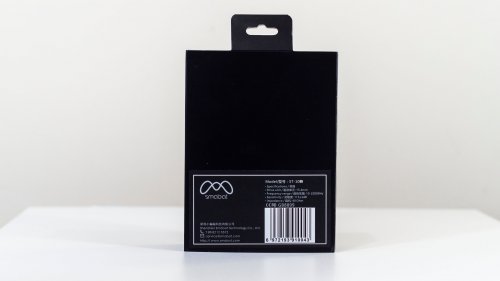
The Smabat ST-10S comes in a black rectangular package. The front panel has a sticker advertising Smabat’s bass-enhancing “Coiling-Up Space Acoustic” technology. A sticker on the back of the package lists specifications for the earbuds and contact information for the manufacturer.
Note: Smabat’s website failed to load at all when I attempted to visit it.
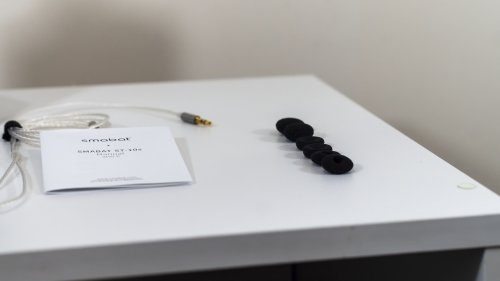
Included with the ST-10 are a pair of full foam covers, a pair of donut foam covers, a pair of full silicone covers, a tan leather pouch embossed with the Smabat logo, and an owner’s manual. The pouch is a hair smaller than the pouch included with the original ST-10 but looks and feels more premium. The pouch uses a magnetic latch instead of a snap clip, which is pretty neat.
BUILD QUALITY AND DESIGN:

The Smabat ST-10S has a two-part design with an outer housing for the MMCX connectors and the bass vent and an inner saucer-shaped driver enclosure. The materials used for the ST-10S are more premium than those of the ST-10 and have better held up to wear over the couple of weeks I have used it.
The outer housing is all-metal with a black glass faceplate, whereas the ST-10’s outer housing was black plastic with a partial aluminum wrap. The bass vent is covered by a polished metal grille on the bottom of the outer housing. The saucer-shaped driver enclosure has a black metal back lined with fine concentric grooves. The rim of the earbud is matte black plastic, and the earbud face grille is polished metal. The Smabat logo is printed on the outward-facing brushed metal surface, and “ST-10S” and “L/R” are printed in line with the MMCX connector. The black glass faceplate is inlaid with the Smabat logo in silver.
The MMCX cable has a clear plastic sheath and metal hardware on the Y-split and 3.5mm jack housing. The MMCX connector housings are also rubber and have raised “L/R” indicators. The cable does not have pre-formed rubber ear guides. The chin slider is clear plastic. The MMCX connectors, the top of the 3.5mm jack, and the bottom of the Y-split have strain relief.
COMFORT, FIT, AND ISOLATION:
The Smabat ST-10S is intended to be worn cable-up only. The ST-10 is comfortable to wear for extended periods. Isolation is non-existent and keeping a secure fit is difficult, as with any earbud.
SOUND:
Note: The following sound impressions are based on listening with the full cloth covers.
The Smabat ST-10 has a neutral tuning.
The ST-10S has a lean, precise bass response with excellent sub-bass extension for an earbud. The sub-bass is roughly in line with the mid-bass in terms of quantity, with some roll-off at the lowest frequencies. The ST-10S generates enough rumble, impact, and slam to enjoy bass-heavy dance tracks without sacrificing resolution, and is very textured. Note attack and decay are fast but not so fast that note weight is compromised. There is no mid-bass bleed into the lower midrange.
The midrange is on the cooler side and emphasizes clarity over warmth and body. Male and female vocals are roughly level with each other, though female vocals have slightly more vibrancy. Male vocals can sound slightly dry. Female vocals approach the edge of sibilance but do not cross the line into harshness. Similarly, there is enough presence to convincingly render the grit of abrasive vocals and electric guitars without straining the ear.
The treble response is slightly elevated, extended, and spacious. Air is emphasized over sparkle. Transients are natural-sounding, and detail retrieval is excellent. Instrument separation, soundstage width and depth, and imaging are impressive as well.
COMPARISONS:
Smabat ST-10S ($119.99) vs Smabat ST-10 ($109.99)
The Smabat ST-10S is a more neutral-sounding earbud than its predecessor. There is less bass emphasis overall and the upper midrange is less intense and shouty. The lower treble is also less forward, which may make the ST-10S more palatable to treble-sensitive listeners. The technicalities and overall resolution of the ST-10S are slightly better.
AMPLIFICATION REQUIREMENTS AND SOURCE PAIRING:
The Smabat ST-10S can be driven to adequate listening volumes with a competent dongle but will benefit from the additional headroom provided by a dedicated source if one wants to listen at high volumes. I did not notice hiss with any of my sources.
CLOSING WORDS:

The Smabat ST-10S improves on the ST-10 in many respects and raises the bar for earbuds just a little bit higher. Recommended.
Nimweth
Headphoneus Supremus
Pros: Extremely natural presentation
Deep bass
Open neutral mids
Clean extended treble
Superb soundstage, separation and layering
High quality construction
Deep bass
Open neutral mids
Clean extended treble
Superb soundstage, separation and layering
High quality construction
Cons: Poor selection of accessories at the price
Large driver may cause fit issues
Large driver may cause fit issues
Smabat are probably best known for their “Maze bass enhancement system” which uses an extended path to bolster the bass output, and which was inspired by transmission line speakers. This was featured in their two previous models, the ST-10 and M1Pro. This system has now been updated and has been renamed “Coiling-up space acoustic”
The Smabat ST-10s replaces the former ST-10 at the top of the range and is offered in two versions, the Black/Silver model reviewed here, which has an impedance of 40 Ohms, and the Black/Gold option, which has a 150 Ohm impedance. The driver is a 15.4mm dynamic unit with a triple sandwich configuration and titanium coated diaphragm and has been revised and improved.
The packaging remains similar to that of the original ST-10. The box is black with an embossed shiny Smabat logo. Opening the box there is a cover over the foam insert containing the earbuds. Below this there is one pair of foam covers, one pair of donut foams and one set of perforated rubber covers. Under the foam insert you will find the silver plated cable with MMCX termination, a faux leather storage pouch and an instruction manual. The presentation is very smart, but a few extra foams and earhooks would have been welcome.
The earpieces are constructed from CNC machined aluminium and feature a black reflective faceplate with silver edging and a white Smabat logo. There is clear channel identification and on the top edge there is a silver-coloured output vent for the bass enhancement system. This channels the bass output of the driver along an extended path in order to supplement the bass response.. The supplied MMCX cable is of high quality silver-plated copper with a straight 3.5mm brushed aluminium plug and a matching Y-split barrel. There is also a clear plastic chin slider. The build quality is excellent.
As with the original ST-10 and M1 Pro, getting a good seal was essential in order to unlock the potential. I obtained the best results wearing them cable down, fitting earhooks from the M1Pro and using the supplied standard full foams.
The ST-10s was used with an Xduoo X20 DAP with a wide range of music across various genres, and auditioning was carried out after a burn in period of 100 hours. Similarly to the M1 Pro and ST-10, I found the ST-10s power-hungry, needing to increase the volume considerably compared to regular IEMs. This was partly necessary to offset the poorer isolation common in earbuds, but also due to the higher impedance.
The ST-10s delivered a sound which was a combination of the previous two models. It possessed the neutral/bright signature of the M1Pro, along with its expansive soundstage and treble extension, but added to this the power and authority of the ST-10. Moreover, the bass performance was superb with extra weight and depth. The new bass enhancement system managed to achieve a satisfying sub-bass response and, like its predecessor, sounded effortless and was reminiscent of listening to speakers rather than earphones.
Bass
The new “coiled-up acoustic space” produced a huge improvement in the bass. Sub-bass now had a satisfying rumble and extension yet remained clean and detailed. The introduction to “Nuvole a Colore” by Rondo Veneziano was a perfect example. The deep synthesised bass foundation was accompanied by violin and percussion and possessed abundant headroom with the powerful chords in the minor key delivering a strong emotional effect. Louis Thiry’s performance of Messaien’s “Desseins Eternels” reproduced the sound of a cathedral organ with all the atmosphere and texture one could wish for. The tonality was natural and airy and was reminiscent of listening to a high quality speaker system fed by a top class turntable, as the bass had a rich, “woody” analogue quality. Decay was also very natural, as evidenced in “Thus Spake Isaiah” from “Belshazzar’s Feast” by William Walton. In the version by the LSO under Andre Previn, the choral parts are underpinned by timpani and bass drum. The depth and resonance here was very natural and believable, adding to the realistic ambience of the recording, a classic by the “dream team” of Christopher Bishop and Christopher Parker.
Midrange
As with the previous ST-10 and M1Pro, there was little or no bass bleed. The generally neutral tonality of the ST-10s was a little warmer than the former models (which is a good thing) but still retained a natural and beautifully balanced quality. The cello and piano in “Bring him Home” by The Piano Guys, displayed an accurate and musical midrange. The harmonic richness, transient attack and authentic timbre combined to magical effect and conveyed all the feeling of the beautiful melody in this sensitive performance. Vocals also benefited from the superb clarity and resolution. Linda Ronstadt’s delicate vocals in “Winter Light” seemed to emerge ethereally above Zbigniew Preisner’s wonderful orchestral arrangement and portrayed the emotion of the story perfectly. Orchestral timbre was very impressive, too. The extended cor anglais solo in Sibelius’s “The Swan of Tuonela” possessed a very natural quality which blended seamlessly with the sombre yet powerful orchestral accompaniment. The other concertante parts also impressed in their accurate positioning in the excellent recording by the London festival Orchestra conducted by Sir Alexander Gibson.
Treble
The ST-10s treble performance maintained the high standards of the rest of the frequency range with clarity, detail and resolution being the watchwords. The crystalline synthesised introduction to “Ice and Air” by Canadian electronic artists Danna and Clement demonstrated the superb separation and precision on offer with the multiple electronic arpeggios clear and discrete even during complex passages of the dense production. The clean and crisp timbre of strings came to the fore in Rossini’s “String Sonata No.1” performed by The Age of Enlightenment Orchestra. The natural harmonics which define the various instruments were wonderfully differentiated giving each instrument real character and producing a very musical effect. Micro-detail was also effective here with subtle and delicate passages easy to discern. The ST-10s was also rhythmically adept and this showed well in Dave Brubeck’s “Unsquare Dance”. The unusual 7/4 time signature produced an infectious rhythm which was highlighted by the handclaps and drumstick work which continued throughout the piece, supported by double bass. The excellent transient response added to the excitement.
Soundstage
As with Smabat’s previous models, soundstage proved to be one of the strengths of the ST-10s, being extensive in all three dimensions with layering, separation and imaging being of the highest standard. The electronic sound effects, guitar parts and synthesised elements in Walter Holland’s “Shades of Night Descending” displayed this to great effect. The ST-10s was able to reproduce a wide spatial field and this was borne out in Kevin Braheny’s “Desert Walkabout” which is an electronic sound picture featuring the “Mighty Serge” synthesiser and Kevin’s expressive Lyricon work. This gave the impression of a huge soundscape populated by delicate percussive elements, gentle chordal passages and electronic nature sounds. Martin Fry’s vocals in “All of my Heart” by ABC really shone in Trevor Horn’s excellent production. As he sings the title line the reverb is removed from his vocal part, bringing the voice into a more intimate space. Contrasted with the rest of the complex production, this was very effective.
Conclusion
Having already tested the two previous models and being very impressed, I was keen to hear the latest iteration and I was not disappointed! There were improvements in all areas, with the best of both previous earbuds being retained and enhancements realised across the board. Bass was deeper with more impact and midrange was clearer and even more detailed. Treble received extra extension and soundstage built on that of the M1 Pro with added focus and separation. Overall the sound was very organic and natural and extremely musical. The build quality is even better than before, and the fit, too, appears to have improved. These ST-10s earbuds are most definitely for music lovers!

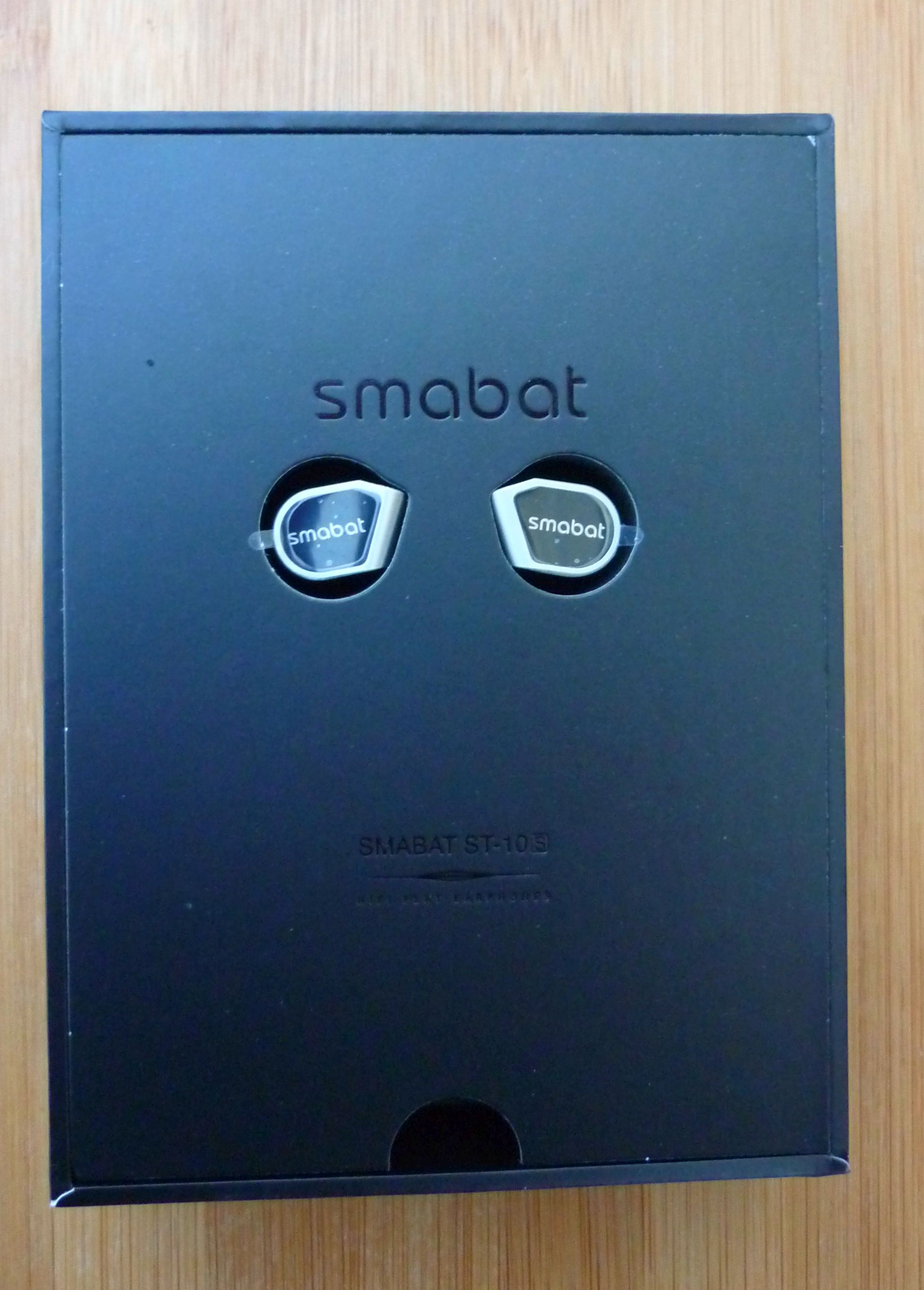

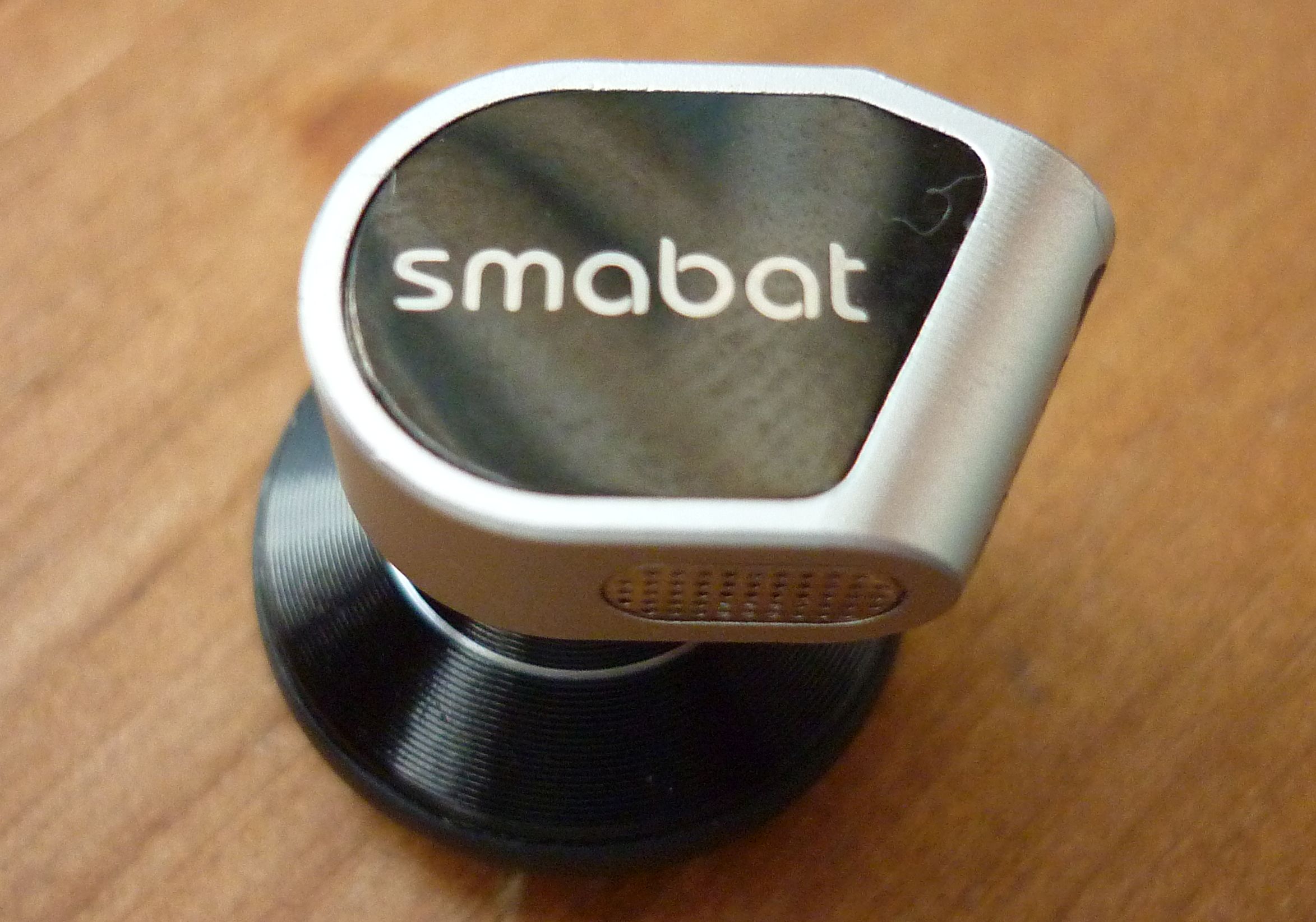
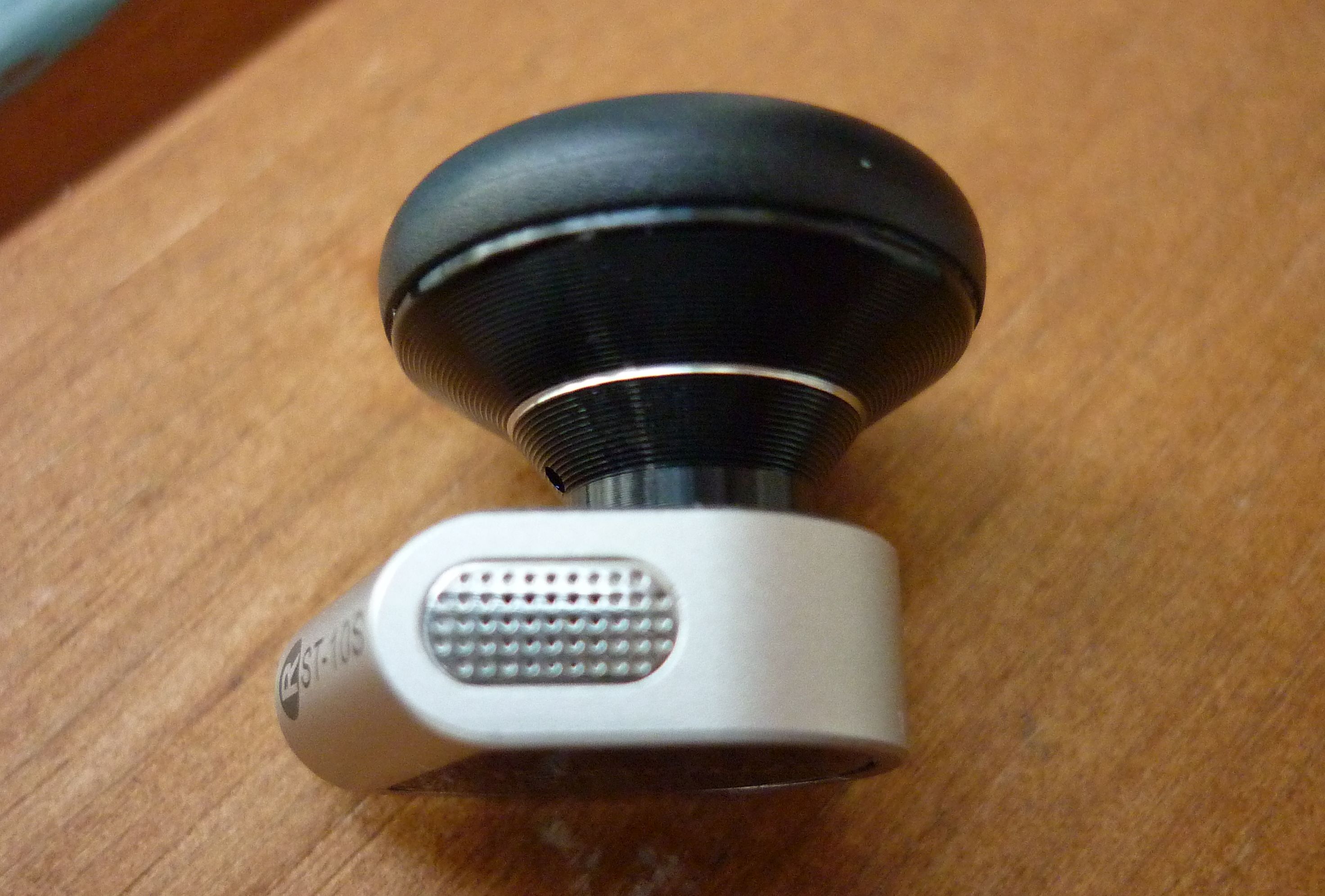
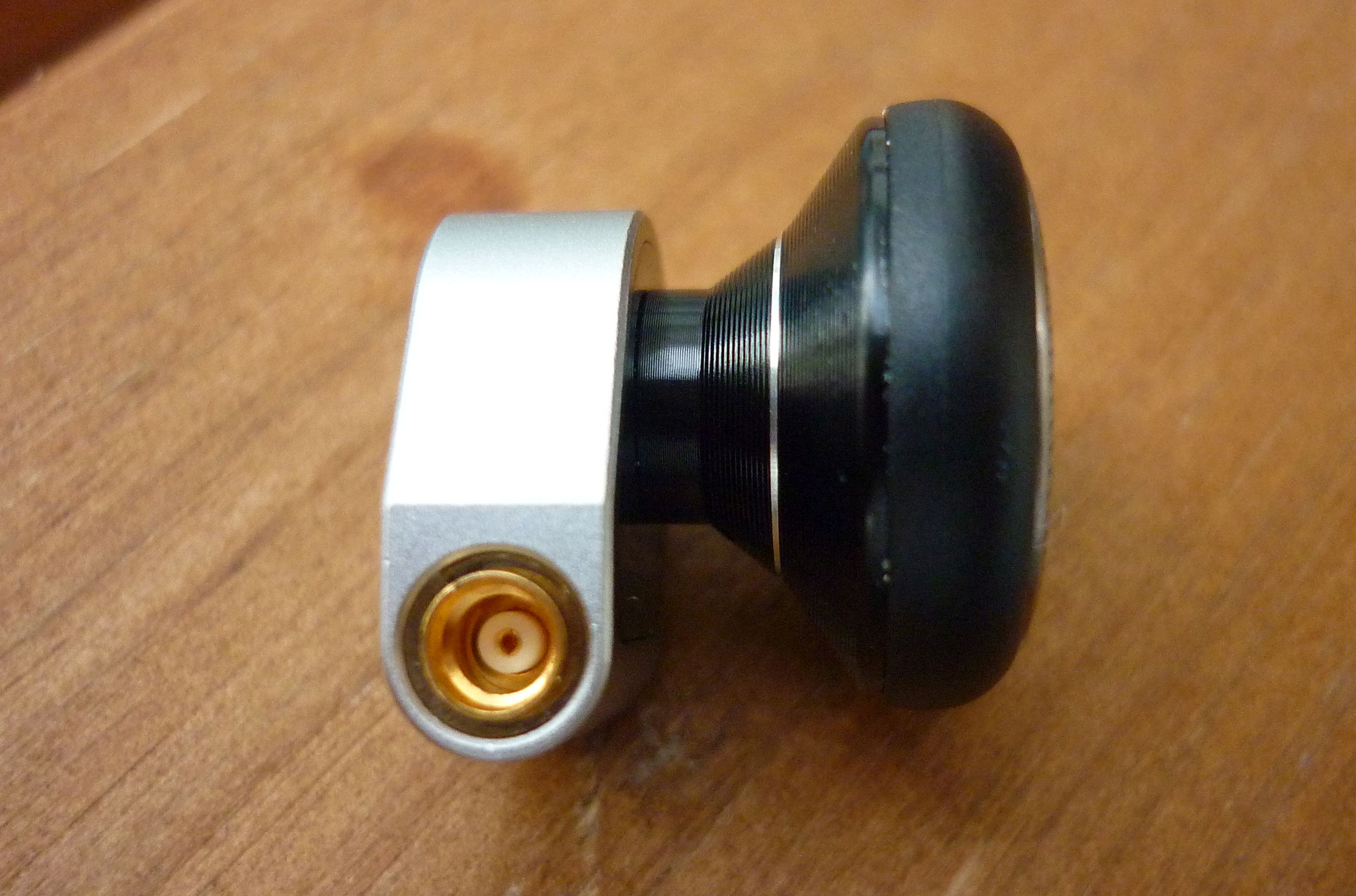
The Smabat ST-10s replaces the former ST-10 at the top of the range and is offered in two versions, the Black/Silver model reviewed here, which has an impedance of 40 Ohms, and the Black/Gold option, which has a 150 Ohm impedance. The driver is a 15.4mm dynamic unit with a triple sandwich configuration and titanium coated diaphragm and has been revised and improved.
The packaging remains similar to that of the original ST-10. The box is black with an embossed shiny Smabat logo. Opening the box there is a cover over the foam insert containing the earbuds. Below this there is one pair of foam covers, one pair of donut foams and one set of perforated rubber covers. Under the foam insert you will find the silver plated cable with MMCX termination, a faux leather storage pouch and an instruction manual. The presentation is very smart, but a few extra foams and earhooks would have been welcome.
The earpieces are constructed from CNC machined aluminium and feature a black reflective faceplate with silver edging and a white Smabat logo. There is clear channel identification and on the top edge there is a silver-coloured output vent for the bass enhancement system. This channels the bass output of the driver along an extended path in order to supplement the bass response.. The supplied MMCX cable is of high quality silver-plated copper with a straight 3.5mm brushed aluminium plug and a matching Y-split barrel. There is also a clear plastic chin slider. The build quality is excellent.
As with the original ST-10 and M1 Pro, getting a good seal was essential in order to unlock the potential. I obtained the best results wearing them cable down, fitting earhooks from the M1Pro and using the supplied standard full foams.
The ST-10s was used with an Xduoo X20 DAP with a wide range of music across various genres, and auditioning was carried out after a burn in period of 100 hours. Similarly to the M1 Pro and ST-10, I found the ST-10s power-hungry, needing to increase the volume considerably compared to regular IEMs. This was partly necessary to offset the poorer isolation common in earbuds, but also due to the higher impedance.
The ST-10s delivered a sound which was a combination of the previous two models. It possessed the neutral/bright signature of the M1Pro, along with its expansive soundstage and treble extension, but added to this the power and authority of the ST-10. Moreover, the bass performance was superb with extra weight and depth. The new bass enhancement system managed to achieve a satisfying sub-bass response and, like its predecessor, sounded effortless and was reminiscent of listening to speakers rather than earphones.
Bass
The new “coiled-up acoustic space” produced a huge improvement in the bass. Sub-bass now had a satisfying rumble and extension yet remained clean and detailed. The introduction to “Nuvole a Colore” by Rondo Veneziano was a perfect example. The deep synthesised bass foundation was accompanied by violin and percussion and possessed abundant headroom with the powerful chords in the minor key delivering a strong emotional effect. Louis Thiry’s performance of Messaien’s “Desseins Eternels” reproduced the sound of a cathedral organ with all the atmosphere and texture one could wish for. The tonality was natural and airy and was reminiscent of listening to a high quality speaker system fed by a top class turntable, as the bass had a rich, “woody” analogue quality. Decay was also very natural, as evidenced in “Thus Spake Isaiah” from “Belshazzar’s Feast” by William Walton. In the version by the LSO under Andre Previn, the choral parts are underpinned by timpani and bass drum. The depth and resonance here was very natural and believable, adding to the realistic ambience of the recording, a classic by the “dream team” of Christopher Bishop and Christopher Parker.
Midrange
As with the previous ST-10 and M1Pro, there was little or no bass bleed. The generally neutral tonality of the ST-10s was a little warmer than the former models (which is a good thing) but still retained a natural and beautifully balanced quality. The cello and piano in “Bring him Home” by The Piano Guys, displayed an accurate and musical midrange. The harmonic richness, transient attack and authentic timbre combined to magical effect and conveyed all the feeling of the beautiful melody in this sensitive performance. Vocals also benefited from the superb clarity and resolution. Linda Ronstadt’s delicate vocals in “Winter Light” seemed to emerge ethereally above Zbigniew Preisner’s wonderful orchestral arrangement and portrayed the emotion of the story perfectly. Orchestral timbre was very impressive, too. The extended cor anglais solo in Sibelius’s “The Swan of Tuonela” possessed a very natural quality which blended seamlessly with the sombre yet powerful orchestral accompaniment. The other concertante parts also impressed in their accurate positioning in the excellent recording by the London festival Orchestra conducted by Sir Alexander Gibson.
Treble
The ST-10s treble performance maintained the high standards of the rest of the frequency range with clarity, detail and resolution being the watchwords. The crystalline synthesised introduction to “Ice and Air” by Canadian electronic artists Danna and Clement demonstrated the superb separation and precision on offer with the multiple electronic arpeggios clear and discrete even during complex passages of the dense production. The clean and crisp timbre of strings came to the fore in Rossini’s “String Sonata No.1” performed by The Age of Enlightenment Orchestra. The natural harmonics which define the various instruments were wonderfully differentiated giving each instrument real character and producing a very musical effect. Micro-detail was also effective here with subtle and delicate passages easy to discern. The ST-10s was also rhythmically adept and this showed well in Dave Brubeck’s “Unsquare Dance”. The unusual 7/4 time signature produced an infectious rhythm which was highlighted by the handclaps and drumstick work which continued throughout the piece, supported by double bass. The excellent transient response added to the excitement.
Soundstage
As with Smabat’s previous models, soundstage proved to be one of the strengths of the ST-10s, being extensive in all three dimensions with layering, separation and imaging being of the highest standard. The electronic sound effects, guitar parts and synthesised elements in Walter Holland’s “Shades of Night Descending” displayed this to great effect. The ST-10s was able to reproduce a wide spatial field and this was borne out in Kevin Braheny’s “Desert Walkabout” which is an electronic sound picture featuring the “Mighty Serge” synthesiser and Kevin’s expressive Lyricon work. This gave the impression of a huge soundscape populated by delicate percussive elements, gentle chordal passages and electronic nature sounds. Martin Fry’s vocals in “All of my Heart” by ABC really shone in Trevor Horn’s excellent production. As he sings the title line the reverb is removed from his vocal part, bringing the voice into a more intimate space. Contrasted with the rest of the complex production, this was very effective.
Conclusion
Having already tested the two previous models and being very impressed, I was keen to hear the latest iteration and I was not disappointed! There were improvements in all areas, with the best of both previous earbuds being retained and enhancements realised across the board. Bass was deeper with more impact and midrange was clearer and even more detailed. Treble received extra extension and soundstage built on that of the M1 Pro with added focus and separation. Overall the sound was very organic and natural and extremely musical. The build quality is even better than before, and the fit, too, appears to have improved. These ST-10s earbuds are most definitely for music lovers!






LinHui
We want to show you our latest product M2 Pro. Currently, the headset has just been released. Unlike other earphones on the market, it is a modular earphone that can be assembled freely by people. In the future, we will also produce more accessories to improve its playability.
If you want to know about our headset, you can click the video link below:
M2Pro:
Official website: www.smabat.com
Product purchase link: https://www.aliexpress.com/item/4001267044768.html
Of course, if you have any questions, you can contact us at any time.
If you want to know about our headset, you can click the video link below:
M2Pro:
Official website: www.smabat.com
Product purchase link: https://www.aliexpress.com/item/4001267044768.html
Of course, if you have any questions, you can contact us at any time.
saldsald
So amongst the T4 BA5 and ST-10s, which is the best do you reckon?
I have both T4 and BA5 just wonder if I need the ST-10s as well...
I have both T4 and BA5 just wonder if I need the ST-10s as well...
Nimweth
Well, the ST-10s is an earbud so not directly comparable to the other two. It has the soundstage you expect from an earbud which is more like full size headphones and a presentation like listening to speakers in a room. T4 is superior to the BA5, IMO.





